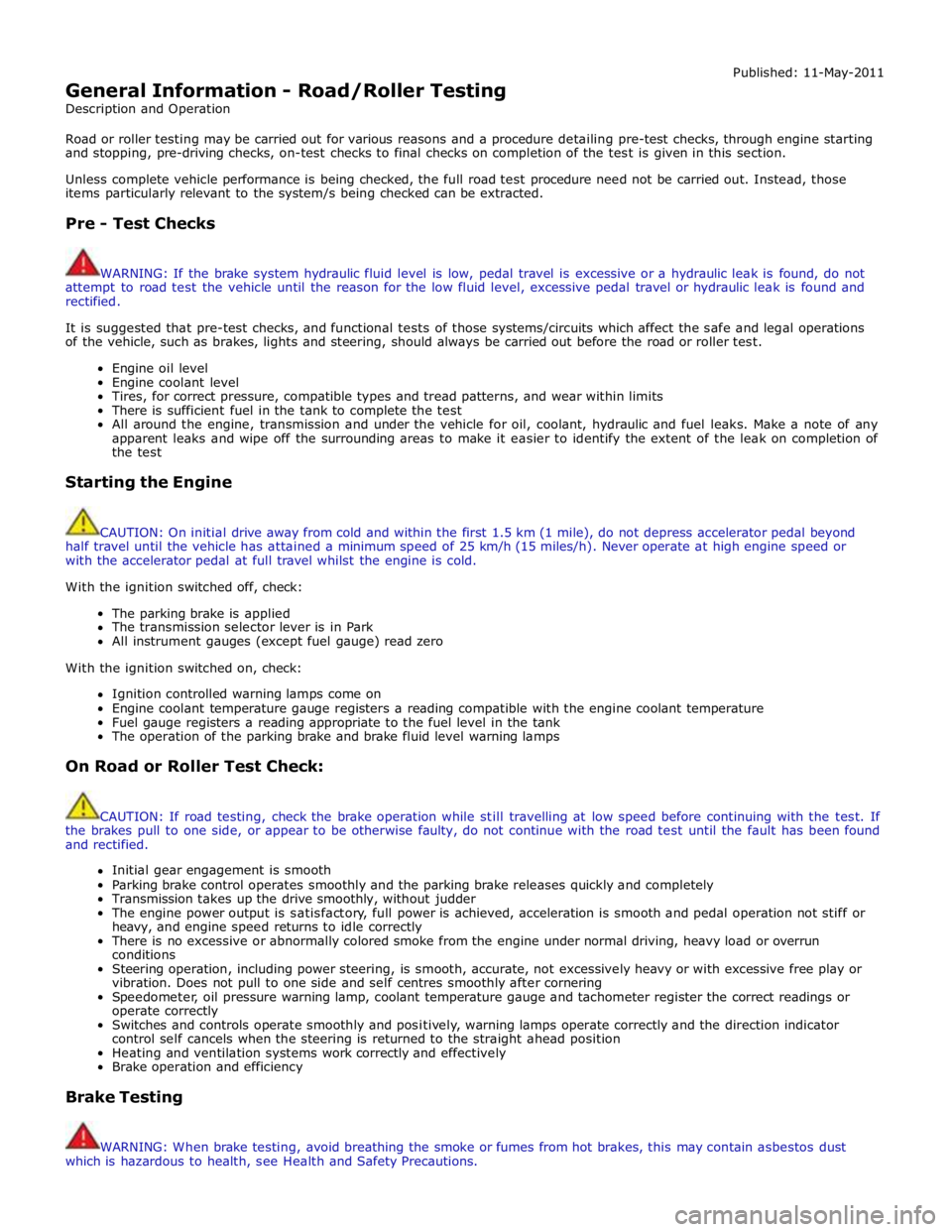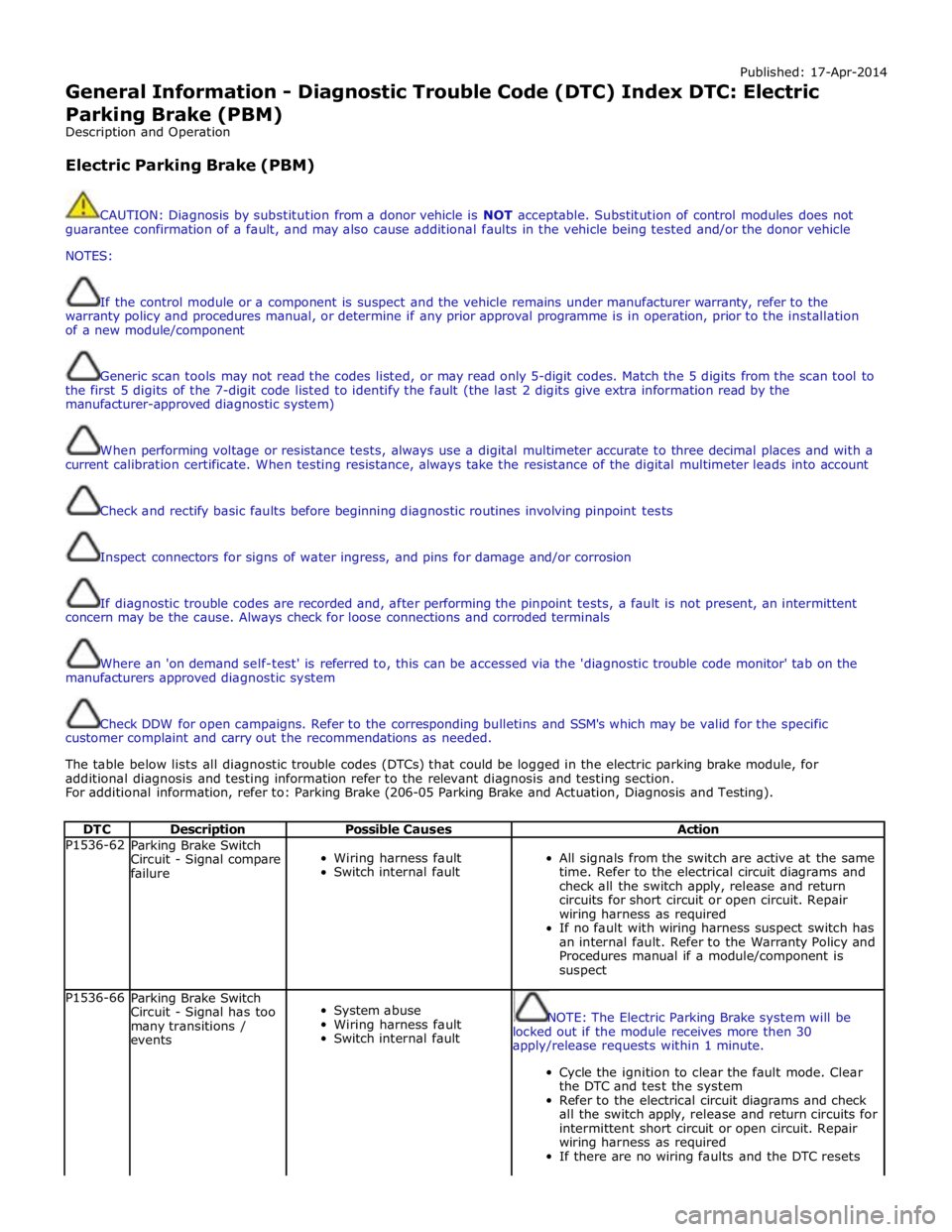2010 JAGUAR XFR Parking
[x] Cancel search: ParkingPage 103 of 3039

General Information - Road/Roller Testing
Description and Operation Published: 11-May-2011
Road or roller testing may be carried out for various reasons and a procedure detailing pre-test checks, through engine starting
and stopping, pre-driving checks, on-test checks to final checks on completion of the test is given in this section.
Unless complete vehicle performance is being checked, the full road test procedure need not be carried out. Instead, those
items particularly relevant to the system/s being checked can be extracted.
Pre - Test Checks
WARNING: If the brake system hydraulic fluid level is low, pedal travel is excessive or a hydraulic leak is found, do not
attempt to road test the vehicle until the reason for the low fluid level, excessive pedal travel or hydraulic leak is found and
rectified.
It is suggested that pre-test checks, and functional tests of those systems/circuits which affect the safe and legal operations
of the vehicle, such as brakes, lights and steering, should always be carried out before the road or roller test.
Engine oil level
Engine coolant level
Tires, for correct pressure, compatible types and tread patterns, and wear within limits
There is sufficient fuel in the tank to complete the test
All around the engine, transmission and under the vehicle for oil, coolant, hydraulic and fuel leaks. Make a note of any
apparent leaks and wipe off the surrounding areas to make it easier to identify the extent of the leak on completion of
the test
Starting the Engine
CAUTION: On initial drive away from cold and within the first 1.5 km (1 mile), do not depress accelerator pedal beyond
half travel until the vehicle has attained a minimum speed of 25 km/h (15 miles/h). Never operate at high engine speed or
with the accelerator pedal at full travel whilst the engine is cold.
With the ignition switched off, check:
The parking brake is applied
The transmission selector lever is in Park
All instrument gauges (except fuel gauge) read zero
With the ignition switched on, check:
Ignition controlled warning lamps come on
Engine coolant temperature gauge registers a reading compatible with the engine coolant temperature
Fuel gauge registers a reading appropriate to the fuel level in the tank
The operation of the parking brake and brake fluid level warning lamps
On Road or Roller Test Check:
CAUTION: If road testing, check the brake operation while still travelling at low speed before continuing with the test. If
the brakes pull to one side, or appear to be otherwise faulty, do not continue with the road test until the fault has been found
and rectified.
Initial gear engagement is smooth
Parking brake control operates smoothly and the parking brake releases quickly and completely
Transmission takes up the drive smoothly, without judder
The engine power output is satisfactory, full power is achieved, acceleration is smooth and pedal operation not stiff or
heavy, and engine speed returns to idle correctly
There is no excessive or abnormally colored smoke from the engine under normal driving, heavy load or overrun
conditions
Steering operation, including power steering, is smooth, accurate, not excessively heavy or with excessive free play or
vibration. Does not pull to one side and self centres smoothly after cornering
Speedometer, oil pressure warning lamp, coolant temperature gauge and tachometer register the correct readings or
operate correctly
Switches and controls operate smoothly and positively, warning lamps operate correctly and the direction indicator
control self cancels when the steering is returned to the straight ahead position
Heating and ventilation systems work correctly and effectively
Brake operation and efficiency
Brake Testing
WARNING: When brake testing, avoid breathing the smoke or fumes from hot brakes, this may contain asbestos dust
which is hazardous to health, see Health and Safety Precautions.
Page 158 of 3039

Published: 17-Apr-2014
General Information - Diagnostic Trouble Code (DTC) Index DTC: Electric
Parking Brake (PBM)
Description and Operation
Electric Parking Brake (PBM)
CAUTION: Diagnosis by substitution from a donor vehicle is NOT acceptable. Substitution of control modules does not
guarantee confirmation of a fault, and may also cause additional faults in the vehicle being tested and/or the donor vehicle
NOTES:
If the control module or a component is suspect and the vehicle remains under manufacturer warranty, refer to the
warranty policy and procedures manual, or determine if any prior approval programme is in operation, prior to the installation
of a new module/component
Generic scan tools may not read the codes listed, or may read only 5-digit codes. Match the 5 digits from the scan tool to
the first 5 digits of the 7-digit code listed to identify the fault (the last 2 digits give extra information read by the
manufacturer-approved diagnostic system)
When performing voltage or resistance tests, always use a digital multimeter accurate to three decimal places and with a
current calibration certificate. When testing resistance, always take the resistance of the digital multimeter leads into account
Check and rectify basic faults before beginning diagnostic routines involving pinpoint tests
Inspect connectors for signs of water ingress, and pins for damage and/or corrosion
If diagnostic trouble codes are recorded and, after performing the pinpoint tests, a fault is not present, an intermittent
concern may be the cause. Always check for loose connections and corroded terminals
Where an 'on demand self-test' is referred to, this can be accessed via the 'diagnostic trouble code monitor' tab on the
manufacturers approved diagnostic system
Check DDW for open campaigns. Refer to the corresponding bulletins and SSM's which may be valid for the specific
customer complaint and carry out the recommendations as needed.
The table below lists all diagnostic trouble codes (DTCs) that could be logged in the electric parking brake module, for
additional diagnosis and testing information refer to the relevant diagnosis and testing section.
For additional information, refer to: Parking Brake (206-05 Parking Brake and Actuation, Diagnosis and Testing).
DTC Description Possible Causes Action P1536-62
Parking Brake Switch
Circuit - Signal compare
failure
Wiring harness fault
Switch internal fault
All signals from the switch are active at the same
time. Refer to the electrical circuit diagrams and
check all the switch apply, release and return
circuits for short circuit or open circuit. Repair
wiring harness as required
If no fault with wiring harness suspect switch has
an internal fault. Refer to the Warranty Policy and
Procedures manual if a module/component is
suspect P1536-66
Parking Brake Switch
Circuit - Signal has too
many transitions /
events
System abuse
Wiring harness fault
Switch internal fault
NOTE: The Electric Parking Brake system will be
locked out if the module receives more then 30
apply/release requests within 1 minute.
Cycle the ignition to clear the fault mode. Clear
the DTC and test the system
Refer to the electrical circuit diagrams and check
all the switch apply, release and return circuits for
intermittent short circuit or open circuit. Repair
wiring harness as required
If there are no wiring faults and the DTC resets
Page 159 of 3039

DTC Description Possible Causes Action suspect the switch. Refer to the Warranty Policy
and Procedures manual if a module/component is
suspect P1571-64
Brake Switch - Signal
plausibility failure
Wiring harness fault
Brake pedal switch fault
The signal from the hardwired brake pedal switch
does not agree with the brake status message
broadcast on CAN. Refer to the electrical circuit
diagrams and check the brake pedal switch
circuits for short circuit or open circuit. Repair
wiring harness as required
If there are no wiring harness faults suspect
switch. Refer to the Warranty Policy and
Procedures manual if a module/component is
suspect C1127-31
Position Sensor - No
Signal
Parking brake motor hall
effect position sensor
power circuit fault
Parking brake motor hall
effect position sensor
ground circuit fault
Parking brake motor hall
effect position sensor
signal circuit fault
Mechanical fault with
sensor/actuator
Inspect mechanical linkages for faults/damage.
Repair as required. Refer to the electrical circuit
diagrams and check parking brake motor hall
effect position sensor circuits for short, open
circuit. Check and install a new sensor actuator as
required C1129-39
Actuator engage -
Incorrect has too few
pulses
Motor engage current
reached before full apply
travel distance
Service brake adjustment
incorrect after brake lining
replacement
Brake cables broken,
seized, trapped.
Caliper malfunction
Carry out parking brake calibration procedure.
check for mechanical failure of parking brake
system C1129-3A
Actuator engage -
Incorrect has too many
pulses
Motor engage current not
reached or travelled too far
upon apply
Service brake adjustment
incorrect after brake lining
replacement
Brake cables broken,
seized, trapped
Caliper malfunction
Carry out parking brake calibration procedure.
check for mechanical failure of parking brake
system C112A-39
Actuator disengage -
Incorrect has too few
pulses
Intermittent motor or
circuit - open circuit
Actuator malfunction
Check for additional motor or circuit DTCs and
refer to DTC index. check for mechanical failure of
parking brake C1D00-11 Park brake apply switch
- Circuit short to ground
Connector fault - bent,
loose or corroded pin(s)
Harness fault - short to
ground
Switch fault
Refer to electrical circuit diagrams and check the
switch primary and secondary apply circuits for
short to ground. Repair circuit faults or install a
new switch as required C1D00-15
Park brake apply switch
circuit - Circuit short to
battery or open
Connector fault - bent,
loose or corroded pin(s)
Harness fault - short to
power or open circuit
Switch fault
Refer to electrical circuit diagrams and check the
switch primary and secondary apply circuits for
short to power or open circuit. Repair circuit faults
or install a new switch as required C1D00-1C Park brake apply switch
- Voltage out of range
Connector fault - bent,
loose or corroded pin(s)
Harness fault - low
resistance to ground
Switch fault
Refer to the electrical circuit diagrams and test
primary parking brake apply switch circuits for
short to ground
Check and install a new switch as required
Page 160 of 3039

DTC Description Possible Causes Action C1D00-62 Park brake apply switch
- Signal compare failure
Connector fault - bent,
loose or corroded pin(s)
Harness fault
Switch fault
Apply switch active then release switch active,
refer to electrical circuit diagrams and check
apply/release switch circuits
Check and install a new switch as required C1D00-64 Park brake apply switch
- Signal plausibility
failure
Connector fault - bent,
loose or corroded pin(s)
Harness fault - primary or
secondary apply circuit
Switch fault
Refer to the electrical circuit diagrams and test
parking brake primary and secondary apply circuits
Check and install a new switch as required C1D01-11
Park brake release
switch - Circuit short to
ground
Connector fault - bent,
loose or corroded pin(s)
Harness fault - short to
ground
Switch fault
Refer to the electrical circuit diagrams and test
park brake primary and secondary circuit for short
to ground
Check and install a new switch as required C1D01-15
Park brake release
switch - Circuit short to
battery or open
Connector fault - bent,
loose or corroded pin(s)
Harness fault - open circuit
Harness fault - short to
power
Switch fault
Refer to the electrical circuit diagrams and test
parking brake primary and secondary release
circuits for open circuits or short to power
Check and install a new switch as required C1D01-1C
Park brake release
switch - Voltage out of
range
Connector fault - bent,
loose or corroded pin(s)
Harness fault - low
resistance to ground
Switch fault
Refer to electrical circuit diagrams and test park
brake switch primary and secondary switch circuits
for low resistance to ground
Check and install a new switch as required C1D01-62
Park brake release
switch - Signal compare
failure
Connector fault - bent,
loose or corroded pin(s)
Harness fault
Switch fault
Release switch active then apply switch active.
Refer to electrical circuit diagrams and check
switch circuits for open circuits or shorts. Repair
circuit or replace switch as required C1D01-64
Park brake release
switch - Signal
plausibility failure
Connector fault - bent,
loose or corroded pin(s)
Harness fault
Switch fault
Primary and secondary release switch inputs
signals do not match. Check connectors for
damaged pins, Refer to electrical circuit diagrams
and check switch circuits for open circuits or
shorts. Repair circuit or replace switch as required B1142-64
Ignition Status 1 -
Signal plausibility
failure
The hard wired ignition
status signal does not
agree with CAN messages.
Ignition power supply is
detected open circuit when
ignition status is set to
'ON'
Refer to electrical circuit diagrams and check
parking brake module ignition power supply for
short to ground, open circuit U0001-87
High Speed CAN
communication bus -
Missing message
CAN Bus circuit fault
Power distribution fault
Refer to the electrical circuit diagrams and check
the power and ground connections to the module.
Using the manufacturer approved diagnostic
system, complete a CAN network integrity test.
Refer to the electrical circuit diagrams and check
the CAN network U0001-88
High speed CAN
communication Bus -
Bus off
CAN Bus circuit fault
Power distribution fault
Refer to the electrical circuit diagrams and check
the power and ground connections to the module.
Using the manufacturer approved diagnostic
system, complete a CAN network integrity test.
Refer to the electrical circuit diagrams and check
the CAN network U0100-00
Lost Communication
with ECM/PCM A - No
sub type information
Engine control module /
system fault
Wiring harness fault
Check the Engine Control Module for related DTCs
and refer to the relevant DTC index
Refer to the electrical circuit diagrams and check
the power and ground connections to the module.
Using the manufacturer approved diagnostic www.JagDocs.com
Page 162 of 3039

DTC Description Possible Causes Action U0423-00 Invalid Data Received
Invalid message from the
Check the Instrument Cluster for related DTCs From Instrument Panel Control Module - No sub instrument panel control and refer to the relevant DTC index type information module U0433-64
Invalid Data Received
From Cruise Control
Front Distance Range
Sensor - Signal
plausibility failure
Incorrect apply request
from the speed control
module when the
conditions were not correct
NOTE: The Park Brake Module has received a
request to apply the parkbrake from the Adaptive Speed
Control module but the conditions were not correct for
the apply to take place. E.g. the vehicle was moving. The
module will ignore the request but this DTC is logged for
safety reference
Check the Speed Control Module for related DTCs
and refer to the relevant DTC index U2001-68
Reduced System
Function - Event
information
Invalid or missing message
from Anti-Lock Braking
System with ignition OFF
and vehicle speed > 3Kph
NOTE: There has been invalid or missing data
detected from the Anti-Lock Brake System Control
Module. This DTC may be logged if the ignition is
switched off with the vehicle still moving. This DTC will
never be recorded as confirmed and is stored for
historical analysis only
Check the Speed Control Module for related DTCs
and refer to the relevant DTC index U2005-64
Vehicle Speed - Signal
implausibility failure
Implausible speed
message from the
Anti-Lock Braking System
control module
NOTE: Implausible speed is defined as passing
from high speed dynamic mode to static mode without
passing through low speed dynamic mode
Check the Anti-Lock Braking System Control
Module for related DTCs and refer to the relevant
DTC index U200D-4B
Control Module Output
Power A - Over
temperature
Actuator FET circuit over
current / over temperature
Refer to electrical wiring diagrams and check the
actuator circuit for low resistance. Repair circuit
faults or install a new actuator as required U2011-11
Motor - Circuit short to
ground
Electric park brake motor
output short to ground
Refer to electrical wiring diagrams and check the
actuator circuit for short to ground. Repair circuit
faults or install a new actuator as required U2011-12
Motor - Circuit short to
battery
Electric park brake motor
output short to power
Refer to electrical wiring diagrams and check the
actuator circuit for short to power. Repair circuit
faults or install a new actuator as required U2011-13 Motor - Circuit open
Electric park brake motor
output open circuit
Refer to electrical wiring diagrams and check the
actuator circuit for open circuit. Repair circuit
faults or install a new actuator as required U3000-47
Control Module -
Watchdog/safety micro
controller failure
Defective ECU
Lost communication with secondary micro
processor, check power and ground connections to
module. Clear DTC, perform battery reset and
retest system. If DTC reoccurs suspect the
Parking Brake control module
Refer to the Warranty Policy and Procedures
manual if a module/component is suspect U3002-81
Vehicle Identification
Number (VIN) - Invalid
serial number
The Park Brake Module has
previously been installed
to another vehicle
Check and install the original, or a new Park Brake
Module
Refer to the Warranty Policy and Procedures
manual if a module/component is suspect U3003-62
Battery Voltage - Signal
compare failure
Power distribution fault
Wiring harness fault
There is a difference of more than 2 volts
between the power supply to the parking brake
module and the battery voltage value broadcast
on CAN. Check other control modules for battery
voltage related DTCs. Refer to the electrical
circuit diagrams and check the power and ground
Page 206 of 3039

Published: 12-May-2014
General Information - Diagnostic Trouble Code (DTC) Index DTC: Parking Aid
Module (PAM)
Description and Operation
Parking Aid Control Module (PACM)
CAUTION: Diagnosis by substitution from a donor vehicle is NOT acceptable. Substitution of control modules does not
guarantee confirmation of a fault, and may also cause additional faults in the vehicle being tested and/or the donor vehicle
NOTES:
If the control module or a component is suspect and the vehicle remains under manufacturer warranty, refer to the
warranty policy and procedures manual, or determine if any prior approval programme is in operation, prior to the installation
of a new module/component.
Generic scan tools may not read the codes listed, or may read only 5-digit codes. Match the 5 digits from the scan tool to
the first 5 digits of the 7-digit code listed to identify the fault (the last 2 digits give extra information read by the
manufacturer-approved diagnostic system)
When performing voltage or resistance tests, always use a digital multimeter accurate to three decimal places and with a
current calibration certificate. When testing resistance, always take the resistance of the digital multimeter leads into account
Check and rectify basic faults before beginning diagnostic routines involving pinpoint tests
Inspect connectors for signs of water ingress, and pins for damage and/or corrosion
If diagnostic trouble codes are recorded and, after performing the pinpoint tests, a fault is not present, an intermittent
concern may be the cause. Always check for loose connections and corroded terminals
Where an 'on demand self-test' is referred to, this can be accessed via the 'diagnostic trouble code monitor' tab on the
manufacturers approved diagnostic system
Check DDW for open campaigns. Refer to the corresponding bulletins and SSMs which may be valid for the specific
customer complaint and carry out the recommendations as required
Physical damage to the sensor (impact damage or scratched sensor surface) must NOT be changed under warranty.
The table below lists all diagnostic trouble codes (DTCs) that could be logged in the Parking Aid Control Module (PACM). For
additional diagnosis and testing information refer to the relevant diagnosis and testing section.
For additional information, refer to: Parking Aid (413-13 Parking Aid, Diagnosis and Testing).
DTC Description Possible Causes Action B1B36-01
Front Right Outer
Sensor - General
Electrical Failure
Wiring harness fault
Front right outer sensor
- Component internal
failure
Refer to electrical wiring diagrams and check the front
bumper harness for damage/corrosion. Check sensor
circuit for short circuit to ground, short circuit to
power, open circuit. Repair or replace any wiring
harness as required
Check the connector for integrity and damage, then
re-connect sensor to confirm connection
Using the manufacturers approved diagnostic system
clear the DTC and run the on demand self test
If the problem persists remove the suspect sensor
from the bumper. Inspect the sensor connector for
signs of water ingress/corrosion. Exchange the
suspect sensor with another sensor within the
bumper that is not reporting a fault. Clear the DTC
and run the on demand self test to confirm if the
fault code now appears for the new position of the
suspect sensor. Renew the faulty sensor www.JagDocs.com
Page 211 of 3039

DTC Description Possible Causes Action bumper that is not reporting a fault. Clear the DTC
and run the on demand self test to confirm if the
fault code now appears for the new position of the
suspect sensor. Renew the faulty sensor B1B50-01 Rear Left Inner Sensor
- General electrical
failure
Wiring harness fault
Rear Left Inner Sensor -
Component internal
failure
Refer to electrical wiring diagrams and check the rear
bumper harness for damage/corrosion. Check sensor
circuit for short circuit to ground, short circuit to
power, open circuit. Repair or replace any wiring
harness as required
Check the connector for integrity and damage, then
re-connect sensor to confirm connection
Using the manufacturers approved diagnostic system
clear the DTC and run the on demand self test
If the problem persists remove the suspect sensor
from the bumper. Inspect the sensor connector for
signs of water ingress/corrosion. Exchange the
suspect sensor with another sensor within the
bumper that is not reporting a fault. Clear the DTC
and run the on demand self test to confirm if the
fault code now appears for the new position of the
suspect sensor. Renew the faulty sensor B1B50-12 Rear Left Inner Sensor
- Circuit short to
battery
Wiring harness fault
Refer to electrical wiring diagrams and check the rear
bumper harness for damage. Check sensor circuit for
short circuit to power. Repair or replace any wiring
harness as required
Check the connector for integrity and damage, then
re-connect sensor to confirm connection
Using the manufacturers approved diagnostic system
clear the DTC and run the on demand self test B1B50-96 Rear Left Inner Sensor
- Component internal
failure
Wiring harness fault
Rear Left Inner Sensor -
Component internal
failure
Refer to electrical wiring diagrams and check the rear
bumper harness for damage/corrosion. Check sensor
circuit for short circuit to ground, short circuit to
power, open circuit. Repair or replace any wiring
harness as required
Check the connector for integrity and damage, then
re-connect sensor to confirm connection
Using the manufacturers approved diagnostic system
clear the DTC and run the on demand self test
If the problem persists remove the suspect sensor
from the bumper. Inspect the sensor connector for
signs of water ingress/corrosion. Exchange the
suspect sensor with another sensor within the
bumper that is not reporting a fault. Clear the DTC
and run the on demand self test to confirm if the
fault code now appears for the new position of the
suspect sensor. Renew the faulty sensor B1B54-11 Function LED - Park Aid
- Circuit short to
ground
Wiring harness fault
Switch/LED - Component
internal failure
Refer to electrical wiring diagrams and check the
parking aid LED circuit for short circuit to ground.
Repair or replace any wiring harness as required
Using the manufacturers approved diagnostic system
clear the DTC and run the on demand self test. If the
problem persists, suspect the switch/LED B1B54-12 Function LED - Park Aid
- Circuit short to
battery
Wiring harness fault
Switch/LED - Component
internal failure
Control Module -
Component internal
failure
Refer to electrical wiring diagrams and check the
parking aid LED circuit for short circuit to power.
Repair or replace any wiring harness as required
Using the manufacturers approved diagnostic system
clear the DTC and run the on demand self test. If the
problem persists, suspect the switch/LED B1B57-11
Front Sensors Power
Circuit- Circuit short to
ground
Wiring harness fault
Control Module -
Component internal
failure
Check front and rear bumper harness for signs of
damage and security of connections
Refer to electrical wiring diagrams and check the
parking assist front sensor power circuit and rear
sensor power circuit for short circuit to ground. Repair
or replace any wiring harness as required
Using the manufacturers approved diagnostic system
clear the DTC and run the on demand self test. If the
problem persists, suspect the control module www.JagDocs.com
Page 212 of 3039

DTC Description Possible Causes Action Cycle the ignition off, then on, to power up parking
aid system and check corrective action B1B58-11
Rear Sensors Power
Circuit - Circuit short
to ground
Wiring harness fault
Control Module -
Component internal
failure
Check rear and front (if front PDC fitted) bumper
harness for signs of damage and security of
connections
Refer to electrical wiring diagrams and check the
parking assist rear sensor power circuit and front
sensor power circuit (if front PDC fitted) for short
circuit to ground. Repair or replace any wiring harness
as required
Using the manufacturers approved diagnostic system
clear the DTC and run the on demand self test. If the
problem persists, suspect the control module
Cycle the ignition off, then on, to power up parking
aid system and check corrective action B1C30-73
Disable Switch -
Actuator stuck closed
Wiring harness fault
Control Switch -
Component internal
failure
Refer to electrical wiring diagrams and check the
parking assist switch and switch circuit. Repair or
replace any wiring harness as required
Using the manufacturers approved diagnostic system
clear the DTC and run the on demand self test. If the
problem persists, suspect the control switch
Check the switch function U0010-00
Medium Speed CAN
Communication Bus -
No sub type
information
Medium speed CAN
failure - bus off
Refer to the electrical circuit diagrams and check the
parking aid control module medium speed CAN bus
for short circuit to ground, short circuit to power,
open circuit, high resistance, or short circuit between
the paired CAN wires
Using the manufacturer approved diagnostic system,
complete a CAN network integrity test
Cycle the ignition off, then on, and check if the DTC
is still logged U0073-00
Control Module
Communication Bus
"A" Off - No sub type
information
Control module
communication Bus "A"
failure - bus off
Refer to the electrical circuit diagrams and check the
parking aid control module high speed CAN bus for
short circuit to ground, short circuit to power, open
circuit, high resistance, or short circuit between the
paired CAN wires
Using the manufacturer approved diagnostic system,
complete a CAN network integrity test
Cycle the ignition off, then on, and check if the DTC
is still logged U0140-00
Lost Communication
With Body Control
Module - No sub type
information
Loss of CAN
communication with
central junction box
Refer to the electrical circuit diagrams and check the
power and ground connections to the central junction
box. Clear DTC and retest
Using the manufacturer approved diagnostic system,
complete a CAN network integrity test. Refer to the
electrical circuit diagrams and check the CAN network
between the central junction box and the parking aid
control module U0142-00 Lost Communication
Loss of CAN
Refer to the electrical circuit diagrams and check the With Body Control Module "B" - No sub communication with power and ground connections to the auxiliary type information auxiliary junction box junction box. Clear DTC and retest Using the manufacturer approved diagnostic system, complete a CAN network integrity test. Refer to the electrical circuit diagrams and check the CAN network between the central junction box and the parking aid control module U0155-00
Lost Communication
With Instrument Panel
Cluster (IPC) Control
Module - No sub type
information
Loss of CAN
communication with
instrument cluster
Refer to the electrical circuit diagrams and check the
power and ground connections to the instrument
cluster. Clear DTC and retest
Using the manufacturer approved diagnostic system,
complete a CAN network integrity test. Refer to the
electrical circuit diagrams and check the CAN network
between the central junction box and the parking aid
control module